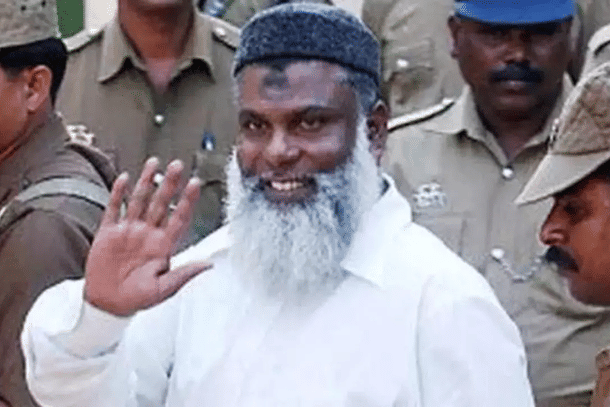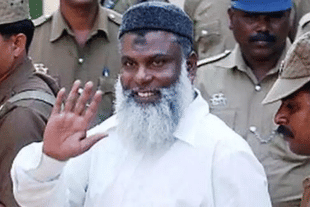Politics
Taking On Islamist Propaganda In Tamil Nadu: Strategize Or Perish
Aravindan Neelakandan
Dec 21, 2024, 09:00 AM | Updated Dec 20, 2024, 07:43 PM IST
Save & read from anywhere!
Bookmark stories for easy access on any device or the Swarajya app.


In the past week, two significant events in Tamil Nadu should concern Hindu Tamils.
1. First, a grand procession, mainly of Muslim youths, took place during the funeral of SA Basha, founder of the radical Islamist organisation Al-Ummah, known for its violent and terrorist activities. Almost all political parties' leaders, except the Bharatiya Janata Party (BJP), expressed condolences, praising Basha as a ‘land-rights activist.’
2. A fabricated controversy emerged about music maestro Ilaiyaraaja being 'humiliated' by Brahmins in Sri Villiputhur temple.
In the 1990s, when Al-Ummah was active, most political parties and even Muslim organisations distanced themselves from it. Basha was seen as a rogue element, bringing disrepute to the community. Wahhabist organizations in Tamil Nadu conducted extensive outreach to the Hindu community, disassociating themselves from Basha and Al-Ummah.
However, this stance has now changed.
These developments should prompt Hindu organisations in Tamil Nadu to reassess and understand the societal shifts effected by manipulated discourse and orchestrated and sustained media campaigns.
Radical fundamentalist elements within the Islamist movement are gaining prominence. Posthumously, Palani Baba, an uncouth fundamentalist known for his vitriolic attacks on politicians, especially Hindu leaders, is being projected as a leader of the subaltern in Tamil Nadu. He positioned his Islamist fundamentalism within the framework of Tamil separatism and subaltern politics.
What was once fringe has now become the mainstream non-BJP political narrative in Tamil Nadu.
Conversely, Hindutva politics is increasingly being associated with caste hierarchy. The orthodox fringe's worldview is used to essentialise the entire Hindu movement.
So, in both the cases the fringe is moving to the centre.
In the case of Muslim politics, the radical fringe is encroaching the space of the mainstream minority politics. This is a calculated strategy.
On the Hindutva side, the orthodox fringe is increasingly positioning itself as mainstream Hindutva. This move is ethically intolerable and strategically self-destructive, yet it complements the Islamist strategy.
Consequently, the political appeal of Hindutva runs the risk of rapidly diminishing.
Consider the Coimbatore blasts of 1998. Over 26 years have passed since then, with the BJP ruling at the Centre for 16 of those years. In Tamil Nadu, from 1999 to 2001 and again from 2016 to 2021, both the DMK and AIADMK, part of the National Democratic Alliance (NDA) at different times, held power.
Despite this, the radical Islamist political lobby skilfully navigated various channels to ensure the main accused in the Coimbatore case received almost 'royal' treatment. Ultimately, he was acquitted during the time of the UPA government.
Contrast the near lack of response from state Hindu organisations, including the BJP with respect to this, with the coordinated campaign by NGOs, media, and political parties, including Congress, which successfully moved case after case related to the Gujarat riots and so-called fake encounter cases outside Gujarat.
The constant political mobilisation of the people and the remembrance of the balidanis of the Hindutva movement—from Prof. Paramasivam to Thenkasi Kumarapandyan and his brothers, to Auditor Ramesh and Pondy Ramalingam—should have been a continuous and sustained effort by the BJP and other Parivar organisations. Instead, they have been reduced to mere memories, revived only on their Balidan Diwas days by the concerned Parivar organisations.
For instance, Prof. Paramasivam is remembered on his Balidas Diwas by a handful of ABVP functionaries in a lacklustre event, and Thenkasi Kumarapandiyan by Hindu Munnani, and so on. This must change.
The situation in Tamil Nadu calls for a people's movement to seek justice for each of the balidanis, a movement that must work tirelessly.
The media campaign to highlight the sequence of events leading to the Coimbatore bomb blasts should have been the primary agenda for any media portal or channel sympathetic to the Hindu cause. Unfortunately, the so-called post-2014 'pro-Hindu' media in Tamil Nadu is more interested in sensationalism and shallow presentations of Sanatana Dharma, reinforcing the caricatures created by Dravidianists.
As a result, forces antithetical to Hindu interests continue their agenda. Their daily talk shows follow the narratives set by their political masters and strategists, manufacturing false fabrications like insults to Ilaiyaraaja, and centring debates around these fabrications. Clips and sound-bytes are then circulated.
Contrast this. When was the last time a Hindu Tamil saw a reel or a sound byte from a talk show run by a 'pro-Hindu' channel that solely focused on the agony and pain of the Coimbatore bomb blast victims?
Such a reel does not exist because a talk show featuring the victims of Islamist violence in Tamil Nadu has never happened.
No such show ever happened with subject experts like police officers, nor did it happen with the victims of the violence. This despite the ABVP of yester-decades producing a comprehensive report, in 1998, of the Islamist activities in Tamil Nadu.
On the other hand, soon after Basha's initial arrest and just a few years after his attacks on Hindu leaders like Rama. Gopalan and Jana Krishnamurthy, a super-hit movie starring Rajnikant titled Basha was released. Millions of Tamil youths chanted ‘Basha Basha’ without realising that they were also chanting the name of a radical Islamist. The same Rajnikanth, from the United States, declared that the Coimbatore bomb blast 'could not have been carried out by Islamists'.
Such moves exemplified the de-sensitisation of general Hindus to radical Islamist terror even as the media progressively intensified its humanisation of Islamist radicals.
What was glaringly absent was even a semblance of a counter-strategy from Hindu organisations. They failed to remind the public of the actual sequence of events, marked by individual acts of radical Islamist violence, culminating in the execution of police official Selvaraj. Then came the Coimbatore bomb blast.
It was not a retaliatory strike but an act of mindless terrorism, the peak of a chain of individual terrorist events.
Unfortunately, there has been no sustained media campaign to convey this truth to the average Hindu and the emerging generation which knows nothing about the violent trajectory of Islamist terror in Tamil Nadu.
These critical acts of omissions by the Hindu Sangathan movement in Tamil Nadu have led to the glorification of a terrorist like Basha as a 'fighter for justice.' It is imperative that Hindu organisations unite, sit together, strategize, and work to reclaim the narrative and discourse in Tamil Nadu.





